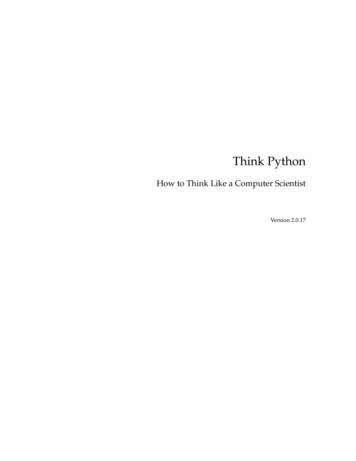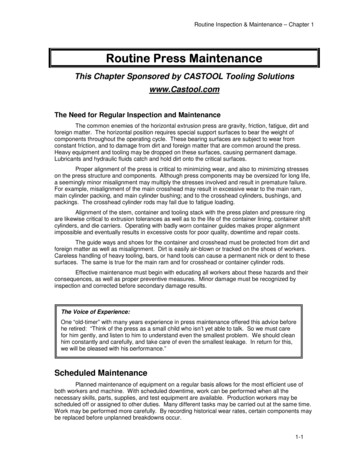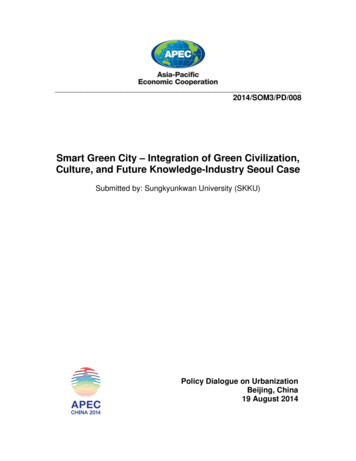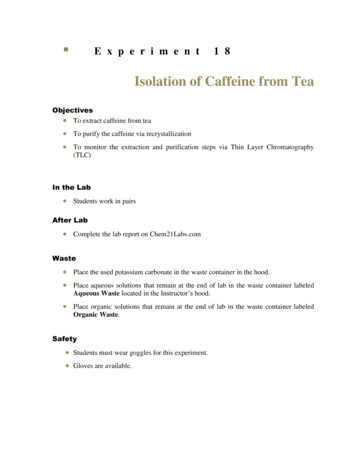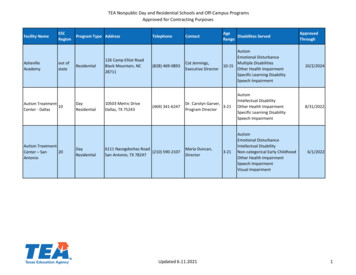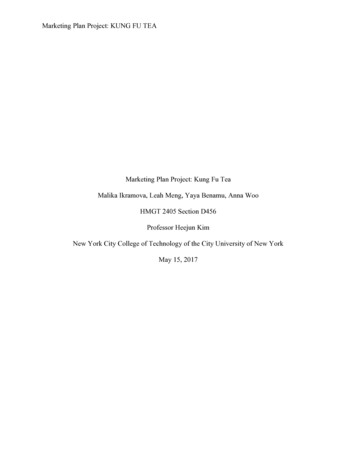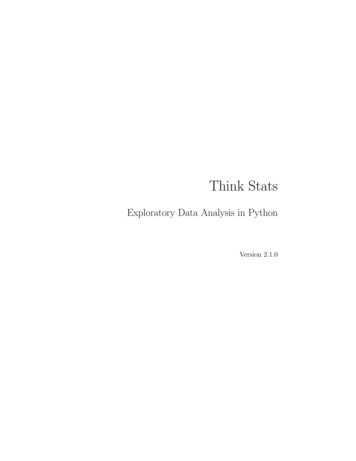
Transcription
Think StatsExploratory Data Analysis in PythonVersion 2.1.0
Think StatsExploratory Data Analysis in PythonVersion 2.1.0Allen B. DowneyGreen Tea PressNeedham, Massachusetts
Copyright c 2014 Allen B. Downey.Green Tea Press9 Washburn AveNeedham MA 02492Permission is granted to copy, distribute, and/or modify this document under theterms of the Creative Commons Attribution-NonCommercial-ShareAlike 4.0 International License, which is available at The original form of this book is LATEX source code. Compiling this code has theeffect of generating a device-independent representation of a textbook, which canbe converted to other formats and printed.The LATEX source for this book is available from http://thinkstats2.com.
PrefaceThis book is an introduction to the practical tools of exploratory data analysis. The organization of the book follows the process I use when I startworking with a dataset: Importing and cleaning: Whatever format the data is in, it usuallytakes some time and effort to read the data, clean and transform it, andcheck that everything made it through the translation process intact. Single variable explorations: I usually start by examining one variableat a time, finding out what the variables mean, looking at distributionsof the values, and choosing appropriate summary statistics. Pair-wise explorations: To identify possible relationships between variables, I look at tables and scatter plots, and compute correlations andlinear fits. Multivariate analysis: If there are apparent relationships between variables, I use multiple regression to add control variables and investigatemore complex relationships. Estimation and hypothesis testing: When reporting statistical results,it is important to answer three questions: How big is the effect? Howmuch variability should we expect if we run the same measurementagain? Is it possible that the apparent effect is due to chance? Visualization: During exploration, visualization is an important toolfor finding possible relationships and effects. Then if an apparent effectholds up to scrutiny, visualization is an effective way to communicateresults.
viChapter 0. PrefaceThis book takes a computational approach, which has several advantagesover mathematical approaches: I present most ideas using Python code, rather than mathematicalnotation. In general, Python code is more readable; also, because it isexecutable, readers can download it, run it, and modify it. Each chapter includes exercises readers can do to develop and solidifytheir learning. When you write programs, you express your understanding in code; while you are debugging the program, you are alsocorrecting your understanding. Some exercises involve experiments to test statistical behavior. Forexample, you can explore the Central Limit Theorem (CLT) by generating random samples and computing their sums. The resulting visualizations demonstrate why the CLT works and when it doesn’t. Some ideas that are hard to grasp mathematically are easy to understand by simulation. For example, we approximate p-values by runningrandom simulations, which reinforces the meaning of the p-value. Because the book is based on a general-purpose programming language(Python), readers can import data from almost any source. They arenot limited to datasets that have been cleaned and formatted for aparticular statistics tool.The book lends itself to a project-based approach. In my class, students workon a semester-long project that requires them to pose a statistical question,find a dataset that can address it, and apply each of the techniques theylearn to their own data.To demonstrate my approach to statistical analysis, the book presents a casestudy that runs through all of the chapters. It uses data from two sources: The National Survey of Family Growth (NSFG), conducted by theU.S. Centers for Disease Control and Prevention (CDC) to gather“information on family life, marriage and divorce, pregnancy, infertility, use of contraception, and men’s and women’s health.” (Seehttp://cdc.gov/nchs/nsfg.htm.)
0.1. How I wrote this bookvii The Behavioral Risk Factor Surveillance System (BRFSS), conductedby the National Center for Chronic Disease Prevention and HealthPromotion to “track health conditions and risk behaviors in the UnitedStates.” (See http://cdc.gov/BRFSS/.)Other examples use data from the IRS, the U.S. Census, and the BostonMarathon.This second edition of Think Stats includes the chapters from the first edition,many of them substantially revised, and new chapters on regression, timeseries analysis, survival analysis, and analytic methods. The previous editiondid not use pandas, SciPy, or StatsModels, so all of that material is new.0.1How I wrote this bookWhen people write a new textbook, they usually start by reading a stack ofold textbooks. As a result, most books contain the same material in prettymuch the same order.I did not do that. In fact, I used almost no printed material while I waswriting this book, for several reasons: My goal was to explore a new approach to this material, so I didn’twant much exposure to existing approaches. Since I am making this book available under a free license, I wanted tomake sure that no part of it was encumbered by copyright restrictions. Many readers of my books don’t have access to libraries of printed material, so I tried to make references to resources that are freely availableon the Internet. Some proponents of old media think that the exclusive use of electronicresources is lazy and unreliable. They might be right about the firstpart, but I think they are wrong about the second, so I wanted to testmy theory.
viiiChapter 0. PrefaceThe resource I used more than any other is Wikipedia. In general, the articles I read on statistical topics were very good (although I made a few smallchanges along the way). I include references to Wikipedia pages throughout the book and I encourage you to follow those links; in many cases, theWikipedia page picks up where my description leaves off. The vocabularyand notation in this book are generally consistent with Wikipedia, unlessI had a good reason to deviate. Other resources I found useful were Wolfram MathWorld and the Reddit statistics forum, http://www.reddit.com/r/statistics.0.2Using the codeThe code and data used in this book are available from https://github.com/AllenDowney/ThinkStats2. Git is a version control system that allowsyou to keep track of the files that make up a project. A collection of filesunder Git’s control is called a repository. GitHub is a hosting service thatprovides storage for Git repositories and a convenient web interface.The GitHub homepage for my repository provides several ways to work withthe code: You can create a copy of my repository on GitHub by pressing the Forkbutton. If you don’t already have a GitHub account, you’ll need tocreate one. After forking, you’ll have your own repository on GitHubthat you can use to keep track of code you write while working on thisbook. Then you can clone the repo, which means that you make a copyof the files on your computer. Or you could clone my repository. You don’t need a GitHub account todo this, but you won’t be able to write your changes back to GitHub. If you don’t want to use Git at all, you can download the files in a Zipfile using the button in the lower-right corner of the GitHub page.All of the code is written to work in both Python 2 and Python 3 with notranslation.I developed this book using Anaconda from Continuum Analytics, which is afree Python distribution that includes all the packages you’ll need to run the
0.2. Using the codeixcode (and lots more). I found Anaconda easy to install. By default it doesa user-level installation, not system-level, so you don’t need administrativeprivileges. And it supports both Python 2 and Python 3. You can downloadAnaconda from http://continuum.io/downloads.If you don’t want to use Anaconda, you will need the following packages: pandas for representing and analyzing data, http://pandas.pydata.org/; NumPy for basic numerical computation, http://www.numpy.org/; SciPy for scientific computation including statistics, http://www.scipy.org/; StatsModels for regression and other statistical analysis, http://statsmodels.sourceforge.net/; and matplotlib for visualization, http://matplotlib.org/.Although these are commonly used packages, they are not included with allPython installations, and they can be hard to install in some environments.If you have trouble installing them, I strongly recommend using Anacondaor one of the other Python distributions that include these packages.After you clone the repository or unzip the zip file, you should have a foldercalled ThinkStats2/code with a file called nsfg.py. If you run nsfg.py, itshould read a data file, run some tests, and print a message like, “All testspassed.” If you get import errors, it probably means there are packages youneed to install.Most exercises use Python scripts, but some also use the IPython notebook.If you have not used IPython notebook before, I suggest you start with thedocumentation at ebook.html.I wrote this book assuming that the reader is familiar with core Python,including object-oriented features, but not pandas, NumPy, and SciPy. Ifyou are already familiar with these modules, you can skip a few sections.
xChapter 0. PrefaceI assume that the reader knows basic mathematics, including logarithms, forexample, and summations. I refer to calculus concepts in a few places, butyou don’t have to do any calculus.If you have never studied statistics, I think this book is a good place to start.And if you have taken a traditional statistics class, I hope this book will helprepair the damage.—Allen B. Downey is a Professor of Computer Science at the Franklin W. OlinCollege of Engineering in Needham, MA.Contributor ListIf you have a suggestion or correction, please send email todowney@allendowney.com. If I make a change based on your feedback, Iwill add you to the contributor list (unless you ask to be omitted).If you include at least part of the sentence the error appears in, that makesit easy for me to search. Page and section numbers are fine, too, but notquite as easy to work with. Thanks! Lisa Downey and June Downey read an early draft and made many corrections and suggestions. Steven Zhang found several errors. Andy Pethan and Molly Farison helped debug some of the solutions, andMolly spotted several typos. Dr. Nikolas Akerblom knows how big a Hyracotherium is. Alex Morrow clarified one of the code examples. Jonathan Street caught an error in the nick of time. Many thanks to Kevin Smith and Tim Arnold for their work on plasTeX,which I used to convert this book to DocBook. George Caplan sent several suggestions for improving clarity.
0.2. Using the codexi Julian Ceipek found an error and a number of typos. Stijn Debrouwere, Leo Marihart III, Jonathan Hammler, and Kent Johnsonfound errors in the first print edition. Jörg Beyer found typos in the book and made many corrections in the docstrings of the accompanying code. Tommie Gannert sent a patch file with a number of corrections. Christoph Lendenmann submitted several errata. Michael Kearney sent me many excellent suggestions. Alex Birch made a number of helpful suggestions. Lindsey Vanderlyn, Griffin Tschurwald, and Ben Small read an early versionof this book and found many errors. John Roth, Carol Willing, and Carol Novitsky performed technical reviewsof the book. They found many errors and made many helpful suggestions. David Palmer sent many helpful suggestions and corrections. Erik Kulyk found many typos. Nir Soffer sent several excellent pull requests for both the book and thesupporting code. GitHub user flothesof sent a number of corrections. Toshiaki Kurokawa, who is working on the Japanese translation of this book,has sent many corrections and helpful suggestions. Benjamin White suggested more idiomatic Pandas code. Takashi Sato spotted an code error.Other people who found typos and similar errors are Andrew Heine, Gábor Lipták,Dan Kearney, Alexander Gryzlov, Martin Veillette, Haitao Ma, Jeff Pickhardt,Rohit Deshpande, Joanne Pratt, Lucian Ursu, Paul Glezen, Ting-kuang Lin, ScottMiller, Luigi Patruno.
xiiChapter 0. Preface
ContentsPrefacev0.1How I wrote this book . . . . . . . . . . . . . . . . . . . . . vii0.2Using the code . . . . . . . . . . . . . . . . . . . . . . . . . . viii1 Exploratory data analysis11.1A statistical approach . . . . . . . . . . . . . . . . . . . . . .21.2The National Survey of Family Growth . . . . . . . . . . . .31.3Importing the data . . . . . . . . . . . . . . . . . . . . . . .41.4DataFrames . . . . . . . . . . . . . . . . . . . . . . . . . . .51.5Variables . . . . . . . . . . . . . . . . . . . . . . . . . . . . .71.6Transformation . . . . . . . . . . . . . . . . . . . . . . . . .81.7Validation . . . . . . . . . . . . . . . . . . . . . . . . . . . . 101.8Interpretation . . . . . . . . . . . . . . . . . . . . . . . . . . 121.9Exercises . . . . . . . . . . . . . . . . . . . . . . . . . . . . . 131.10Glossary . . . . . . . . . . . . . . . . . . . . . . . . . . . . . 15
xivContents2 Distributions172.1Histograms . . . . . . . . . . . . . . . . . . . . . . . . . . . . 172.2Representing histograms . . . . . . . . . . . . . . . . . . . . 182.3Plotting histograms . . . . . . . . . . . . . . . . . . . . . . . 192.4NSFG variables . . . . . . . . . . . . . . . . . . . . . . . . . 192.5Outliers . . . . . . . . . . . . . . . . . . . . . . . . . . . . . 222.6First babies . . . . . . . . . . . . . . . . . . . . . . . . . . . 232.7Summarizing distributions . . . . . . . . . . . . . . . . . . . 252.8Variance . . . . . . . . . . . . . . . . . . . . . . . . . . . . . 262.9Effect size . . . . . . . . . . . . . . . . . . . . . . . . . . . . 272.10Reporting results . . . . . . . . . . . . . . . . . . . . . . . . 282.11Exercises . . . . . . . . . . . . . . . . . . . . . . . . . . . . . 282.12Glossary . . . . . . . . . . . . . . . . . . . . . . . . . . . . . 293 Probability mass functions313.1Pmfs . . . . . . . . . . . . . . . . . . . . . . . . . . . . . . . 313.2Plotting PMFs3.3Other visualizations . . . . . . . . . . . . . . . . . . . . . . . 353.4The class size paradox . . . . . . . . . . . . . . . . . . . . . 353.5DataFrame indexing3.6Exercises . . . . . . . . . . . . . . . . . . . . . . . . . . . . . 413.7Glossary . . . . . . . . . . . . . . . . . . . . . . . . . . . . . 43. . . . . . . . . . . . . . . . . . . . . . . . . 33. . . . . . . . . . . . . . . . . . . . . . 39
Contentsxv4 Cumulative distribution functions454.1The limits of PMFs . . . . . . . . . . . . . . . . . . . . . . . 454.2Percentiles . . . . . . . . . . . . . . . . . . . . . . . . . . . . 464.3CDFs . . . . . . . . . . . . . . . . . . . . . . . . . . . . . . . 484.4Representing CDFs . . . . . . . . . . . . . . . . . . . . . . . 494.5Comparing CDFs . . . . . . . . . . . . . . . . . . . . . . . . 504.6Percentile-based statistics . . . . . . . . . . . . . . . . . . . . 514.7Random numbers . . . . . . . . . . . . . . . . . . . . . . . . 524.8Comparing percentile ranks . . . . . . . . . . . . . . . . . . 544.9Exercises . . . . . . . . . . . . . . . . . . . . . . . . . . . . . 554.10Glossary . . . . . . . . . . . . . . . . . . . . . . . . . . . . . 555 Modeling distributions575.1The exponential distribution . . . . . . . . . . . . . . . . . . 575.2The normal distribution . . . . . . . . . . . . . . . . . . . . 605.3Normal probability plot . . . . . . . . . . . . . . . . . . . . . 625.4The lognormal distribution . . . . . . . . . . . . . . . . . . . 655.5The Pareto distribution . . . . . . . . . . . . . . . . . . . . . 675.6Generating random numbers . . . . . . . . . . . . . . . . . . 695.7Why model? . . . . . . . . . . . . . . . . . . . . . . . . . . . 705.8Exercises . . . . . . . . . . . . . . . . . . . . . . . . . . . . . 715.9Glossary . . . . . . . . . . . . . . . . . . . . . . . . . . . . . 73
xviContents6 Probability density functions756.1PDFs . . . . . . . . . . . . . . . . . . . . . . . . . . . . . . . 756.2Kernel density estimation . . . . . . . . . . . . . . . . . . . . 776.3The distribution framework . . . . . . . . . . . . . . . . . . 796.4Hist implementation . . . . . . . . . . . . . . . . . . . . . . 806.5Pmf implementation . . . . . . . . . . . . . . . . . . . . . . 816.6Cdf implementation . . . . . . . . . . . . . . . . . . . . . . . 826.7Moments . . . . . . . . . . . . . . . . . . . . . . . . . . . . . 846.8Skewness . . . . . . . . . . . . . . . . . . . . . . . . . . . . . 856.9Exercises . . . . . . . . . . . . . . . . . . . . . . . . . . . . . 886.10Glossary . . . . . . . . . . . . . . . . . . . . . . . . . . . . . 897 Relationships between variables917.1Scatter plots . . . . . . . . . . . . . . . . . . . . . . . . . . . 917.2Characterizing relationships . . . . . . . . . . . . . . . . . . 957.3Correlation . . . . . . . . . . . . . . . . . . . . . . . . . . . . 967.4Covariance . . . . . . . . . . . . . . . . . . . . . . . . . . . . 977.5Pearson’s correlation . . . . . . . . . . . . . . . . . . . . . . 987.6Nonlinear relationships . . . . . . . . . . . . . . . . . . . . . 1007.7Spearman’s rank correlation . . . . . . . . . . . . . . . . . . 1017.8Correlation and causation . . . . . . . . . . . . . . . . . . . 1027.9Exercises . . . . . . . . . . . . . . . . . . . . . . . . . . . . . 1037.10Glossary . . . . . . . . . . . . . . . . . . . . . . . . . . . . . 103
Contentsxvii8 Estimation1058.1The estimation game . . . . . . . . . . . . . . . . . . . . . . 1058.2Guess the variance . . . . . . . . . . . . . . . . . . . . . . . 1078.3Sampling distributions . . . . . . . . . . . . . . . . . . . . . 1098.4Sampling bias . . . . . . . . . . . . . . . . . . . . . . . . . . 1128.5Exponential distributions . . . . . . . . . . . . . . . . . . . . 1138.6Exercises . . . . . . . . . . . . . . . . . . . . . . . . . . . . . 1158.7Glossary . . . . . . . . . . . . . . . . . . . . . . . . . . . . . 1169 Hypothesis testing1179.1Classical hypothesis testing . . . . . . . . . . . . . . . . . . . 1179.2HypothesisTest . . . . . . . . . . . . . . . . . . . . . . . . . 1199.3Testing a difference in means . . . . . . . . . . . . . . . . . . 1219.4Other test statistics . . . . . . . . . . . . . . . . . . . . . . . 1239.5Testing a correlation . . . . . . . . . . . . . . . . . . . . . . 1249.6Testing proportions . . . . . . . . . . . . . . . . . . . . . . . 1259.7Chi-squared tests . . . . . . . . . . . . . . . . . . . . . . . . 1279.8First babies again . . . . . . . . . . . . . . . . . . . . . . . . 1289.9Errors . . . . . . . . . . . . . . . . . . . . . . . . . . . . . . 1309.10Power . . . . . . . . . . . . . . . . . . . . . . . . . . . . . . 1309.11Replication . . . . . . . . . . . . . . . . . . . . . . . . . . . . 1329.12Exercises . . . . . . . . . . . . . . . . . . . . . . . . . . . . . 1339.13Glossary . . . . . . . . . . . . . . . . . . . . . . . . . . . . . 134
xviiiContents10 Linear least squares13710.1Least squares fit . . . . . . . . . . . . . . . . . . . . . . . . . 13710.2Implementation . . . . . . . . . . . . . . . . . . . . . . . . . 13910.3Residuals . . . . . . . . . . . . . . . . . . . . . . . . . . . . . 14010.4Estimation . . . . . . . . . . . . . . . . . . . . . . . . . . . . 14110.5Goodness of fit . . . . . . . . . . . . . . . . . . . . . . . . . 14410.6Testing a linear model . . . . . . . . . . . . . . . . . . . . . 14610.7Weighted resampling . . . . . . . . . . . . . . . . . . . . . . 14810.8Exercises . . . . . . . . . . . . . . . . . . . . . . . . . . . . . 15010.9Glossary . . . . . . . . . . . . . . . . . . . . . . . . . . . . . 15011 Regression15311.1StatsModels . . . . . . . . . . . . . . . . . . . . . . . . . . . 15411.2Multiple regression . . . . . . . . . . . . . . . . . . . . . . . 15611.3Nonlinear relationships . . . . . . . . . . . . . . . . . . . . . 15811.4Data mining . . . . . . . . . . . . . . . . . . . . . . . . . . . 15911.5Prediction . . . . . . . . . . . . . . . . . . . . . . . . . . . . 16111.6Logistic regression . . . . . . . . . . . . . . . . . . . . . . . . 16311.7Estimating parameters . . . . . . . . . . . . . . . . . . . . . 16511.8Implementation . . . . . . . . . . . . . . . . . . . . . . . . . 16611.9Accuracy . . . . . . . . . . . . . . . . . . . . . . . . . . . . . 16811.10 Exercises . . . . . . . . . . . . . . . . . . . . . . . . . . . . . 16911.11 Glossary . . . . . . . . . . . . . . . . . . . . . . . . . . . . . 170
Contentsxix12 Time series analysis17312.1Importing and cleaning . . . . . . . . . . . . . . . . . . . . . 17412.2Plotting . . . . . . . . . . . . . . . . . . . . . . . . . . . . . 17612.3Linear regression . . . . . . . . . . . . . . . . . . . . . . . . 17812.4Moving averages . . . . . . . . . . . . . . . . . . . . . . . . . 18012.5Missing values . . . . . . . . . . . . . . . . . . . . . . . . . . 18212.6Serial correlation . . . . . . . . . . . . . . . . . . . . . . . . 18312.7Autocorrelation . . . . . . . . . . . . . . . . . . . . . . . . . 18512.8Prediction . . . . . . . . . . . . . . . . . . . . . . . . . . . . 18712.9Further reading . . . . . . . . . . . . . . . . . . . . . . . . . 19212.10 Exercises . . . . . . . . . . . . . . . . . . . . . . . . . . . . . 19212.11 Glossary . . . . . . . . . . . . . . . . . . . . . . . . . . . . . 19313 Survival analysis19513.1Survival curves . . . . . . . . . . . . . . . . . . . . . . . . . 19513.2Hazard function . . . . . . . . . . . . . . . . . . . . . . . . . 19813.3Inferring survival curves . . . . . . . . . . . . . . . . . . . . 19913.4Kaplan-Meier estimation . . . . . . . . . . . . . . . . . . . . 20013.5The marriage curve . . . . . . . . . . . . . . . . . . . . . . . 20213.6Estimating the survival curve . . . . . . . . . . . . . . . . . 20313.7Confidence intervals . . . . . . . . . . . . . . . . . . . . . . . 20413.8Cohort effects . . . . . . . . . . . . . . . . . . . . . . . . . . 20613.9Extrapolation . . . . . . . . . . . . . . . . . . . . . . . . . . 20913.10 Expected remaining lifetime . . . . . . . . . . . . . . . . . . 21013.11 Exercises . . . . . . . . . . . . . . . . . . . . . . . . . . . . . 21413.12 Glossary . . . . . . . . . . . . . . . . . . . . . . . . . . . . . 214
xxContents14 Analytic methods21714.1Normal distributions . . . . . . . . . . . . . . . . . . . . . . 21714.2Sampling distributions . . . . . . . . . . . . . . . . . . . . . 21914.3Representing normal distributions . . . . . . . . . . . . . . . 22014.4Central limit theorem . . . . . . . . . . . . . . . . . . . . . . 22114.5Testing the CLT . . . . . . . . . . . . . . . . . . . . . . . . . 22214.6Applying the CLT . . . . . . . . . . . . . . . . . . . . . . . . 22714.7Correlation test . . . . . . . . . . . . . . . . . . . . . . . . . 22814.8Chi-squared test . . . . . . . . . . . . . . . . . . . . . . . . . 23014.9Discussion . . . . . . . . . . . . . . . . . . . . . . . . . . . . 23214.10 Exercises . . . . . . . . . . . . . . . . . . . . . . . . . . . . . 233Index235
Chapter 1Exploratory data analysisThe thesis of this book is that data combined with practical methods cananswer questions and guide decisions under uncertainty.As an example, I present a case study motivated by a question I heard whenmy wife and I were expecting our first child: do first babies tend to arrivelate?If you Google this question, you will find plenty of discussion. Some peopleclaim it’s true, others say it’s a myth, and some people say it’s the other wayaround: first babies come early.In many of these discussions, people provide data to support their claims. Ifound many examples like these:“My two friends that have given birth recently to their first babies, BOTH went almost 2 weeks overdue before going into labouror being induced.”“My first one came 2 weeks late and now I think the second oneis going to come out two weeks early!!”“I don’t think that can be true because my sister was my mother’sfirst and she was early, as with many of my cousins.”Reports like these are called anecdotal evidence because they are basedon data that is unpublished and usually personal. In casual conversation,
2Chapter 1. Exploratory data analysisthere is nothing wrong with anecdotes, so I don’t mean to pick on the peopleI quoted.But we might want evidence that is more persuasive and an answer that ismore reliable. By those standards, anecdotal evidence usually fails, because: Small number of observations: If pregnancy length is longer for firstbabies, the difference is probably small compared to natural variation.In that case, we might have to compare a large number of pregnanciesto be sure that a difference exists. Selection bias: People who join a discussion of this question might beinterested because their first babies were late. In that case the processof selecting data would bias the results. Confirmation bias: People who believe the claim might be more likelyto contribute examples that confirm it. People who doubt the claimare more likely to cite counterexamples. Inaccuracy: Anecdotes are often personal stories, and often misremembered, misrepresented, repeated inaccurately, etc.So how can we do better?1.1A statistical approachTo address the limitations of anecdotes, we will use the tools of statistics,which include: Data collection: We will use data from a large national survey thatwas designed explicitly with the goal of generating statistically validinferences about the U.S. population. Descriptive statistics: We will generate statistics that summarize thedata concisely, and evaluate different ways to visualize data. Exploratory data analysis: We will look for patterns, differences, andother features that address the questions we are interested in. At thesame time we will check for inconsistencies and identify limitations.
1.2. The National Survey of Family Growth3 Estimation: We will use data from a sample to estimate characteristicsof the general population. Hypothesis testing: Where we see apparent effects, like a differencebetween two groups, we will evaluate whether the effect might havehappened by chance.By performing these steps with care to avoid pitfalls, we can reach conclusionsthat are more justifiable and more likely to be correct.1.2The National Survey of Family GrowthSince 1973 the U.S. Centers for Disease Control and Prevention (CDC)have conducted the National Survey of Family Growth (NSFG), which isintended to gather “information on family life, marriage and divorce, pregnancy, infertility, use of contraception, and men’s and women’s health. Thesurvey results are used . . . to plan health services and health education programs, and to do statistical studies of families, fertility, and health.” Seehttp://cdc.gov/nchs/nsfg.htm.We will use data collected by this survey to investigate whether first babiestend to come late, and other questions. In order to use this data effectively,we have to understand the design of the study.The NSFG is a cross-sectional study, which means that it captures a snapshot of a group at a point in time. The most common alternative is a longitudinal study, which observes a group repeatedly over a period of time.The NSFG has been conducted seven times; each deployment is called acycle. We will use data from Cycle 6, which was conducted from January2002 to March 2003.The goal of the survey is to draw conclusions about a population; thetarget population of the NSFG is people in the United States aged 15-44.Ideally surveys would collect data from every member of the population,but that’s seldom possible. Instead we collect data from a subset of the
4Chapter 1. Exploratory data analysispopulation called a sample. The people who participate in a survey arecalled respondents.In general, cross-sectional studies are meant to be representative, whichmeans that every member of the target population has an equal chance ofparticipating. That ideal is hard to achieve in practice, but people whoconduct surveys come as close as they can.The NSFG is not representative; instead it is deliberately oversampled. Thedesigners of the study recruited three groups—Hispanics, African-Americansand teenagers—at rates higher than their representation in the U.S. population, in order to make sure that the number of respondents in each of thesegroups is large enough to draw valid statistical inferences.Of course, the drawback of oversampling is that it is not as easy to drawconclusions about the general population based on statistics from the survey.We will come back to this point later.When working with this kind of data, it is important to be familiar withthe codebook, which documents the design of the study, the survey questions, and the encoding of the responses. The codebook and user’s guide forthe NSFG data are available from rting the dataThe code and data used in this book are available from https://github.com/AllenDowney/ThinkStats2. For information about downloading andworking with this code, see Section 0.2.Once you download the code, you should have a file calledThinkStats2/code/nsfg.py. If you run it, it should read a data file,run some tests, and print a message like, “All tests passed.”Let’s see what it does. Pregnancy data from Cycle 6 of the NSFG is in a filecalled 2002FemPreg.dat.gz; it is a gzip-compressed data file in plain text(ASCII), with fixed width columns. Each line in the file is a record thatcontains data about one pregnancy.
1.4. DataFrames5The format of the file is documented in 2002FemPreg.dct, which is a Statadictionary file. Stata is a statistical software system; a “dictionary” in thiscontext is a list of variable names, types, and indices that identify where ineach line to
If you have never studied statistics, I think this book is a good place to start. And if you have taken a traditional statistics class, I hope this book will help repair the damage. Allen B. Downey is a Professor of Computer Science at the Franklin W. Oli
